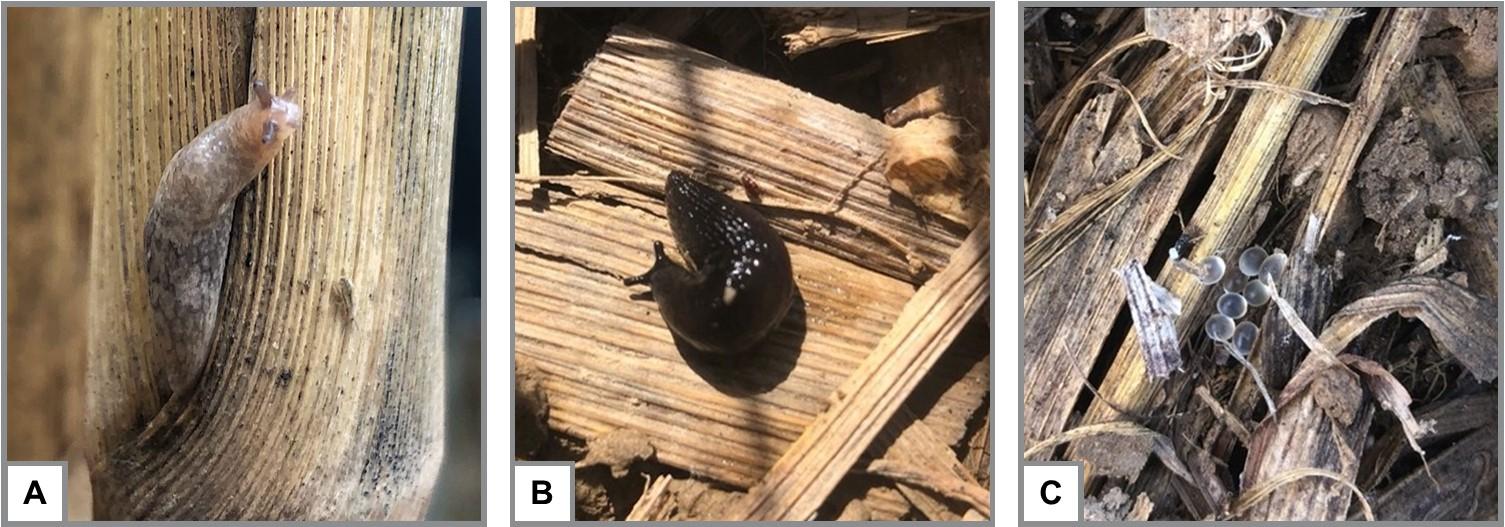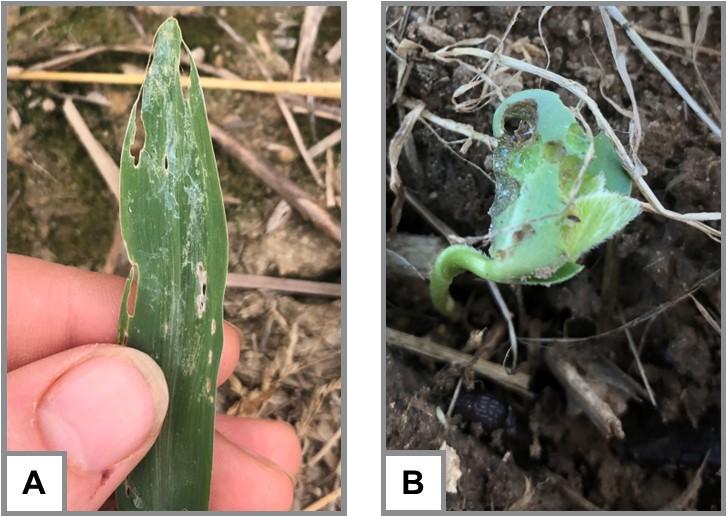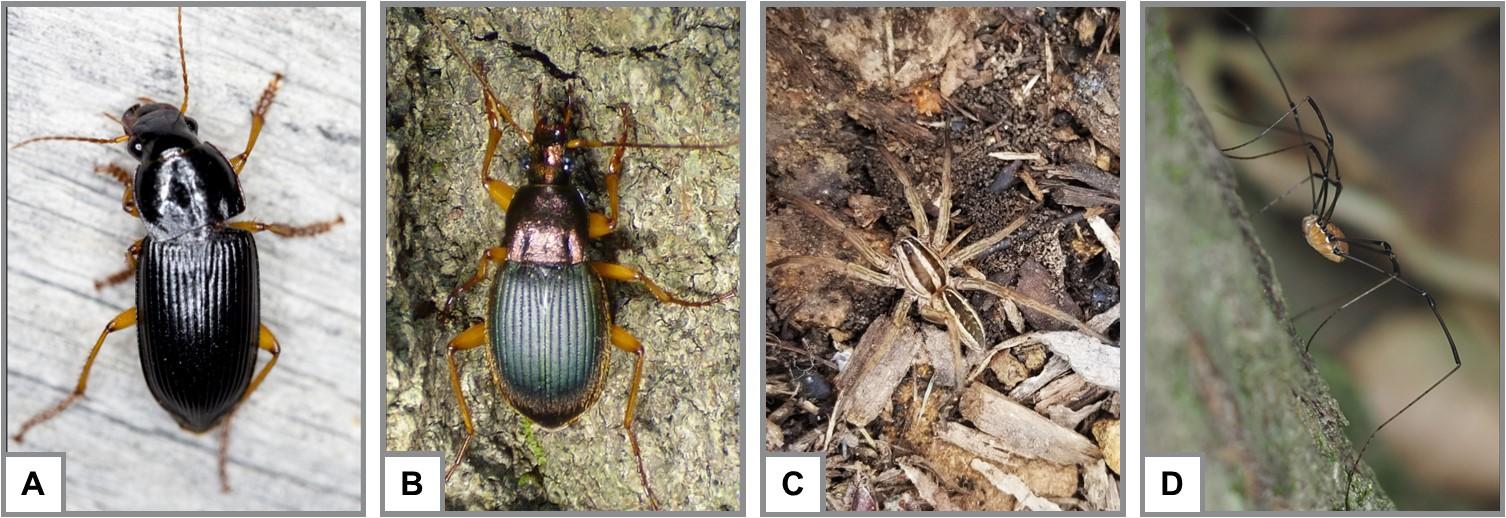
FS-2022-0629 | February 2023
Managing Slugs in Field Crops Using IPM Principles
Slugs are pests of many field crops, including corn and soybean. When particularly abundant and active they can reduce stand density, sometimes so much that the crop must be replanted. Management can be difficult for several reasons: nocturnal activity, easily confused damage, and limited options for reducing populations. The few available chemical pesticides are relatively expensive and may be difficult to apply. An Integrated Pest Management (IPM) approach relies upon accurately identifying the pest and monitoring to determine pest pressure. IPM combines multiple tactics, using chemical pesticides when and where they are most likely to deliver economic returns, cultural practices that decrease pest impact, and biological controls that take advantage of natural enemies. The combination of informed decision-making and multi-pronged pest management helps reduce yield losses and maximize profits.
Identification

Slugs are shell-less mollusks that secrete a slimy mucus that they leave behind as they travel. The most abundant and damaging species in mid-Atlantic crop fields are the exotic gray garden slug (Deroceras reticulatum) and the native marsh slug (Deroceras laeve) (Douglas and Tooker 2017). Gray garden slugs are about 2 inches long when fully grown, and vary in color, ranging from cream-colored with irregular gray spots to dark brown with dark spots (Figure 1A). Marsh slugs are smaller, about 1 inch long, and tend to be darker (Figure 1B). Eggs of both species are small, clear, round, and gelatinous (Figure 1C). They are usually laid in clusters under residue and old stalks (Douglas and Tooker 2017).
Lifecycle
Slug life stages (egg, juvenile, and adult) are generally not synchronized, so often most stages can be found most times of the year (Douglas and Tooker 2017). Gray garden slugs in mid-Atlantic states tend to overwinter as eggs and hatch in early spring, but during mild winters, adults will also overwinter. Marsh slugs can overwinter in all life stages (Getz 1959, Douglas and Tooker 2017). This means growers are likely to find marsh slugs throughout the year, but may not find juvenile gray garden slugs or their damage until eggs hatch in the spring.
Damage

Slugs are problematic because they feed on the leaves and fruits of a wide range of field and horticultural crops; however, they are omnivores and will additionally consume fungi, dead insects, worms, other slugs, and crop residue (Douglas and Tooker 2017). They damage crops by rasping holes in leaves with a file-like mouthpart called a radula. This mouthpart differs from the chewing or piercing mouthparts of insects and scrapes holes in corn leaves and pits in soybean cotyledons (Figure 2). Dried mucus can also be visible on damaged plants.
The most severe damage occurs when slugs feed upon and kill crop seedlings, reducing crop stand establishment. In corn, the growing point remains underground until 5-7 leaves have developed, so seedlings usually survive and outgrow slug damage (Flessner and Taylor 2021). For soybeans, slugs can more easily kill the whole seedling because the cotyledons and growing point are both vulnerable and above ground. Corn and soybean seeds can also be killed pre-emergence (Douglas and Tooker 2017). Slugs cannot burrow underground so they must be able to access the seed for this to happen, for example, if the seed slot does not fully close during planting. Beyond stand reduction, slugs’ foliar feeding may cause yield losses in corn and soybean depending on weather, plant growth stage, and degree of defoliation, but this topic requires more research. Soybean seedlings can withstand a significant amount of defoliation without losing yield (at least 50% defoliation of unifoliate and 1st trifoliate leaves when damage is simulated by researchers), although heavily defoliated soybean plants may grow more slowly (Hammond 2000).
Monitoring

Monitoring slug activity is not difficult, but it can be inconvenient because slugs are primarily nocturnal (Flessner and Taylor 2021). Slugs are most active on warm, moist, calm nights, and observers can find them feeding on plants with the help of a flashlight. During the day, slugs hide under residue and in soil cracks. Slugs can also be monitored using shelter or refuge traps made of squares of white roofing shingles or heavy cardboard that create cool environments for slugs to gather in the field (Figure 3). Traps should be checked early in the morning before they heat up in the sun. In late fall and early spring, shingles may accumulate slugs throughout the day if temperatures are cool. In fields with a history of slug damage, monitoring pre-planting can help locate hotspots or determine if cultural or chemical controls might be useful (Douglas and Tooker 2017). A few studies have correlated slug numbers with damage and stand loss providing preliminary treatment thresholds that have not been examined across locations and climates in corn or soybeans (Douglas and Tooker 2017, Busch et al. 2020).
Chemical Control
When using pesticides, the label is the law. Make sure the product you use is registered in your state and for your crop(s). Follow all application restrictions.
The majority of insecticides used for early-season corn pests (seed treatments and in-furrow insecticides) do not affect slugs, and can be detrimental to slug natural enemies. Molluscicides can be used, but they are relatively expensive, difficult to apply and dispense evenly, and have inconsistent efficacy when cool, rainy conditions follow application. Baits need to be applied when slugs are active and will feed on them, while contact treatments need to be applied when slugs are feeding on plants, usually at night. Both work best when dry weather follows applications so that slugs are not able to recover.
Slug baits rely upon one of two active ingredients: metaldehyde and iron phosphate (Sullivan 2015, Flessner and Taylor 2021). For example, Deadline Bullet® and Deadline M-Ps® contain metaldehyde, whereas Ferrox AQ® and Sluggo® contain iron phosphate. Sluggo® can be used in organic production. Most products provide good control in side by side comparisons, though weathering and specific formulation can impact efficacy (Whalen et al. 2014, Sullivan 2015, Kuhar et al. 2016). Spreading pelleted products at a lower rate in a band over the row (e.g. 10 lbs/acre for Deadline M-Ps) can be a more efficient use of baits, improving cost-effectiveness of the product. Currently, there are no known resistance issues.
Some growers use a “home remedy,” applying 30% urea-based nitrogen diluted 1:1 with water to seedlings at night when slugs are actively feeding (Tooker and Douglas 2017). In Maryland field trials, this treatment reduced slugs by about 70% while minimizing phytotoxicity to the corn foliage. Growers using this treatment will need to adjust nitrogen application rates to keep in compliance with nutrient management plans (Dively and Patton 2022). This practice may not be economic when the cost of nitrogen is high.
Cultural Control
Growers can impact crop favorability for slugs during planting, reducing slug activity, development, and survival. Slug populations are more likely to be damaging in poorly drained fields with a lot of surface residue and little to no soil disturbance (Douglas and Tooker 2017). Making the area directly around seedlings less hospitable to slugs can reduce damage. Using row cleaners on the planter to remove plant residue from a 10-12” wide zone on the surface of the seed row can reduce slug activity and feeding damage, and also improve plant emergence. Make sure the closing wheels and downforce mechanisms of the planter are adjusted to completely seal the seed furrow and prevent the formation of “slug highways.” In consistently problematic fields, or in years with heavy slug pressure, tillage may help, if compatible with your soil management practices.
Practices that encourage soybean and corn seedlings to grow quickly can reduce both their vulnerability to slug feeding and the impact of slug damage, such as delaying planting until soil temperatures are warm enough for rapid germination. In corn fields with slug problems, plant hybrids with excellent emergence and early season vigor ratings and use starter fertilizer to boost early season growth (Douglas and Tooker 2017).
Biological Control

Multiple arthropod predators, especially ground beetles, centipedes, wolf spiders, and harvestmen, feed on slugs (Figure 4) (Douglas and Tooker 2017, Brichler 2020). However, neonicotinoid seed treatments and other early season broad-spectrum insecticide applications can decrease predator populations and indirectly increase the risk of slug damage (Douglas et al. 2015, Hill et al. 2017). When possible, avoid early season insecticide applications such as pyrethroid tank mixtures with burndown herbicides and insecticidal seed treatments to help conserve these natural enemies.
While the greater residue and moisture associated with conservation tillage may increase slug problems, no-till systems can support higher abundance of many predatory insects (Rowen et al. 2020). Specific cover crops and planting green likely also influence populations of slugs and slug predators. Researchers are currently investigating how to best take advantage of these practices (Brichler 2020, Le Gall et al. 2022).
Conclusion
Slugs tend to cause problems in low-disturbance fields with lots of residue, especially in wet springs following mild winters. They are most damaging in soybeans, where the seedlings are more vulnerable, but can cause losses in both corn and soybeans, as well as other field crops, especially if the seed slot does not close well during planting. An IPM approach that includes identifying and monitoring slug populations and damage in these higher-risk situations, and cultural practices like using row cleaners, planting into warm soil, and avoiding broad-spectrum insecticides can all help manage slugs.
Additional Information
- “Slugs as Pests of Field Crops” (2017). Douglas, M. and Tooker, J. Penn State Extension. https://extension.psu.edu/slugs-as-pests-of-field-crops
- “Slug Pests in Field Crops” (2016). Dreves, A.J., Hoffman, G., and Rao, S. Oregon State University Extension Service. https://www.google.com/url?sa=t&source=web&rct=j&opi=89978449&url=https://extension.oregonstate.edu/sites/default/files/documents/em9153.pdf&ved=2ahUKEwilnf3o7J2KAxUhP2IAHX-PJ_sQFnoECDEQAQ&usg=AOvVaw321fX6smxTFMUDsNfHzFCt
References
- Brichler, K. Effects of Farm Management Practices on Pest Slugs and Slug Predators in Field Crops. Virginia Polytechnic Institute and State University. 6 May, 2020. https://vtechworks.lib.vt.edu/bitstream/handle/10919/ 98469/Brichler_KN_T_2020.pdf?sequence=1&is Allowed=y
- Busch, A.K., M.R. Douglas, G.M. Malcolm, H.D. Karsten, J.F. Tooker. A high-diversity/IPM cropping system fosters beneficial arthropod populations, limits invertebrate pests, and produces competitive maize yields. Agriculture, Ecosystems, and the Environment. Volume 292, 7 January 2020. Pages: 106812. https://doi.org/10.1016/j.agee.2019.106812
- Dively, G.P., T. Patton. An Evaluation of Cultural and Chemical Control Practices to Reduce Slug Damage in No-till Corn. Insects, Volume 13, Issue 3, March 2022, Pages: 277. https://doi.org/10.3390/insects13030277
- Douglas, M.R., J.F. Tooker. Slug (Mollusca: Agriolimacidae, Arionidae) Ecology and Management in No-Till Field Crops, With an Emphasis on the mid-Atlantic Region, Journal of Integrated Pest Management, Volume 3, Issue 1, 1 March 2012, Pages C1–C9, https://doi.org/10.1603/IPM11023
- Douglas, M.R., J.R. Rohr, J.F. Tooker. Neonicotinoid insecticide travels through a soil food chain, disrupting biological control of non-target pests and decreasing soya bean yield, Journal of Applied Ecology, Volume 52, 2015 Pages 250-260, https://doi.org/10.1111/1365-2664.12372
- Flessner, M., S.V. Taylor. 2022 Field Crops Pest Management Guide. Virginia Coop Ext. https://www.pubs.ext.vt.edu/content/dam/pubs_ext_vt_edu/ 456/456-016/ENTO-461.pdf
- Getz, L.L.. Notes on the Ecology of Slugs: Arion circumscriptus, Deroceras reticulatum, and D. laeve. The American Midland Naturalist, Volume 61, Issue 2, April 1959, Pages 485-498, https://doi.org/10.2307/2422516
- Hammond, R.B. Simulation of moderate levels of slug injury to soybean, Crop Protection, Volume 19, Issue 2, March 2000, Pages 113–120, https://doi.org/ 10.1016/S0261-2194(99)00087-3
- Hill, M.P., S. Macfadyen, M.A. Nash. Broad spectrum pesticide application alters natural enemy communities and may facilitate secondary pest outbreaks, PeerJ, 5, 2017, Page: e4179, https://doi.org/10.7717/peerj.4179
- Kuhar, T., K. Mooneyham, C. Laub, V. Tech. Evaluation of the Residual Efficacy of Commercial Slug Baits. Virginia Cooperative Extension, 2016, Pages 1-3. https://www.pubs.ext.vt.edu/content/dam/pubs_ext_vt_edu/ENTO/ENTO-178/ENTO-401.pdf
- Le Gall, M., M. Boucher, J.F. Tooker. Planted-green cover crops in maize/soybean rotations confer stronger bottom-up than top-down control of slugs. Agriculture, Ecosystems, and the Environment. Volume 334, March 2022, Pages: 107980. https://doi.org/10.1016/j.agee.2022.107980
- Rowen, E.K., K.H. Regan, M.E. Barbercheck, J.F. Tooker. Is tillage beneficial or detrimental for insect and slug management? A meta-analysis. Agriculture, Ecosystems, and the Environment. Volume 294, 7 February 2020, Pages: 106849. https://doi.org/10.1016/j.agee.2020.106849
- Sullivan, C.S. Evaluation of a Newly Formulated Slug Bait (Ferroxx Aq) for Control of Gray Field Slugs in Western Oregon. 2015 Seed Production Research at Oregon State University, CrS 152, Pages 15-17. https://cropandsoil. oregonstate.edu/sites/agscid7/files/crop-soil/Sullivan_slug_bait.pdf
- Whalen, J., B. Cissel, P. Sylvester. Chemical management of slugs in no-till corn and soybean systems. Mid-Atlantic Regional Agronomist Quarterly Newsletter, Pages 8-16. https://www.grains.spes.vt.edu/articles/MA_newsletter/ 2014%20March%20Regional%20Agronomy%20Newsletter.pdf
PRAISE-GOD IGWE
pigwe@umd.edu
MARIA CRAMER
mec@umd.edu
DAVID OWENS
owensd@umd.edu
GALEN DIVELY
galen@umd.edu
KELLY HAMBY
kahamby@umd.edu
This publication, Managing Slugs in Field Crops Using IPM Principles (FS-2022-0629) is a part of a collection produced by the University of Maryland Extension within the College of Agriculture and Natural Resources.
The information presented has met UME peer-review standards, including internal and external technical review. For help accessing this or any UME publication contact: itaccessibility@umd.edu
For more information on this and other topics, visit the University of Maryland Extension website at extension.umd.edu
University programs, activities, and facilities are available to all without regard to race, color, sex, gender identity or expression, sexual orientation, marital status, age, national origin, political affiliation, physical or mental disability, religion, protected veteran status, genetic information, personal appearance, or any other legally protected class.